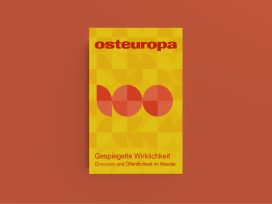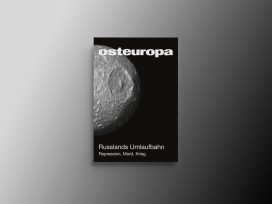Abstracts Osteuropa 12/2005
Karl Schlögel
On the futility of a professor’s life. Otto Hoetzsch and the study of Russia in Germany
In 1946, Otto Hoetzsch called upon scholars to incorporate Russia and eastern Europe into their view of history. This was the conclusion he had reached after a lifetime of research. In Berlin during the 1920s, Hoetzsch, who was a scholar, politician, and tireless man of action, created networks of people interested in Russia regardless of their ideological differences. He founded the Deutsche Gesellschaft für Osteuropakunde and the journal Osteuropa. Hoetzsch organized and inspired Russian emigrants, Baltic Germans, and Soviet Russians. After World War I, Berlin was recognized throughout the world as the centre of scholarly work on Russia and eastern Europe. The Nazis defamed Hoetzsch as a “parlour Bolshevik”, destroyed academic research on eastern Europe, and unleashed war in Europe. And after World War II, Otto Hoetzsch and his pan-European perspective suffered their final defeat in the shape of the division of Europe.
Michael Kohlstruck
“Parlour Bolshevik” and pioneer in social research. Klaus Mehnert and the German Association for the Study of Eastern Europe 1931-1934
Between 1931 and 1933, Klaus Mehnert (1906-1984) served as general secretary of the German Association for the Study of Eastern Europe. As early as the 1920s, Mehnert, who was born in Moscow, was fascinated by the tempo and élan behind the changes taking place in the Soviet Union. He called for similar far-reaching changes in Germany – in terms of style, not content. This enthusiasm was in line with his intervention on behalf of the Rapallo line of foreign policy cooperation between the German Reich and the Soviet Union. Politically, Mehnert belonged to Otto Strasser’s Black Front. As a result, trouble loomed on the horizon when the National Socialists came to power.
Intermezzo
“My book on Soviets is making the rounds in pirated form”. With Oskar Anweiler on a tour d’horizon
The educationalist and historian of eastern Europe Oskar Anweiler associates something in particular with Osteuropa: He and the journal were launched in 1925. This provides an occasion to accompany Anweiler on a biographical tour d’horizon. It begins in multi-ethnic Galicia, follows the Hitler-Stalin pact and explores the consequences of the Second World War for the intellectual conflict with eastern Europe in the postwar era. Anweiler witnessed the construction of a new style of German eastern European studies and held discussions with the 1960s student movement on state communism and the Soviet system. Here, he reflects on the meaning of détente and the political position of east European studies. He also ponders the consequences of the end of the East-West conflict for his own worldview and his perception of himself as an academic. Interdisciplinary and comparative studies remain centre stage. Oskar Anweiler’s life and the 80 years of Osteuropa have something in common. Both are a mirror of their times.
Dietrich Beyrau
An inconspicuous drama. The journal Osteuropa under National Socialism
To this day, there are files from the German Foreign Office in Moscow’s “Special Archive”. These records shed light on the work of the German Association for the Study of Eastern Europe and the journal Osteuropa between 1933 and 1939. After the National Socialists came to power, both the association and the journal were eyed with distrust. For Nazi experts on eastern Europe, these were Weimar Republic institutions. Those responsible for the association, men such as Otto Hoetzsch, Klaus Mehnert, und Werner Markert, let themselves be drawn into a balancing act between exercising their competences and conforming to the new rulers. The assumption that, as an “extension of the Foreign Office”, they would be immune to political attacks or compromising themselves proved an illusion. The association’s situation became increasingly precarious. Prominent representatives were driven into inner immigration or exile. Others paid for their conformity by becoming ominously close to sharing convictions held by the Nazis’ experts for eastern Europe. The background to the association’s disbanding and the journal’s suspension in 1939 remains in the dark.
Ray Brandon
“Political views: Jew”. Wolfgang Johannes Leppmann (1902-1943)
In the Weimar Republic, Berlin was the centre of eastern European studies. Wolfgang Leppmann was a part of the up-and-coming generation of academics in those days. The Slavicist and historian, one of Otto Hoetzsch’s doctoral candidates, worked in the German Association for the Study of Eastern Europe and published on numerous occasions in Osteuropa. From 1931 until 1934, Leppmann supported Hoetzsch as academic assistant in editing and publishing the collection of sources Die internationalen Beziehungen im Zeitalter des Imperialismus [International relations in the age of imperialism]. After the Nazis seized power, Leppmann – who did not think of himself as a Jew, but was considered one by the regime – found himself a target of Nazi racial policy. The greater part of Leppmann’s family and Jewish colleagues managed to flee. He could not bring himself to leave Germany. When he was called to report for deportation, he went into hiding, but was caught soon thereafter. Wolfgang Leppmann died in Auschwitz in 1943.
Intermezzo
Where history crawls on the skin… Katharina Raabe on literature from Europe’s east
Katharina Raabe, book editor for Suhrkamp, analyzes the metabolism that takes place between reading and experience. She reveals what is particular about eastern European literature and points out the hurdles to be overcome before authors such as Andrukhovych, Cosic, Darvasi, or Stasiuk can establish themselves in the German book market. Non-fiction books about eastern Europe are particularly difficult to publish. Books from the pen of inspired vagabonds are more and more important for intellectually tapping into this realm. In this particular genre, geographical, political, and historical aspects converge. Journals such as Osteuropa will remain important if they succeed in becoming forums where authors can explain the latest developments with greater reflection and more penetrating analysis than newspapers allow, and if they can overcome the anachronistic dichotomy between academic journal and popular magazine.
Corinna R. Unger
“Objective but not neutral”. On the development of Ostforschung after 1945
Despite the burden of its association with National Socialism, Ostforschung managed to establish itself in West Germany as an academic discipline after 1945. This was due to the flexibility of its advocates, who knew how to make themselves and their research conform to the new political conditions: On the one hand, they stressed the political uses of their work for the dispute over the Oder-Neisse line and the issue of the German expellees from beyond that line; on the other hand, the Cold War provided a convenient means for suppressing individual incrimination in and German responsibility for Nazi crimes committed in eastern and central Europe during the Second World War. Only in the course of the 1960s did this field shed the German-centric, often anti-communist orientation that had dominated it for so long.
Sebastian Lentz & Stella Schmid
Blue giant. The view of eastern European space 1951-1955
From the resumption of publication in 1951 until the end of 1955, the journal Osteuropa had as its cover a silhouette of eastern Europe against a blue background. One saw the excerpt of a world map produced using the Mercator projection. This had the drawback of faithfully reproducing surfaces only along the equator. The closer the map came to the poles, the greater the distortion. Vis-à-vis northern Siberia, India appears absurdly small. Intentionally or unintentionally, this map conveys differing views of eastern Europe. It could visualize a political definition of eastern Europe that embraces not only the Soviet Union but also the People’s Republic of China. At the same time, it could have served in the Cold War era to depict the communist threat. No less unlikely is that it is simply a graphic means of representation. The woodcut style, almost expressionist in its portrayal of eastern Europe, speaks for this theory.
Intermezzo
A uniform English jargon is the wrong track. Bodo von Greiff on periodicals, academia, and politics
Bodo von Greiff, the editor of the journal Leviathan, sings a hymn of praise for interdisciplinary studies, speaks of overcoming Weber’s division of science and policy, muses over the connection between language and knowledge, diagnoses a childish tendency among authors, analyzes the challenges of publishing a magazine while steering between patronage and advertising for back supports with reading glasses, and reminds us that even the rules governing the right of way in Roman chariot races can yield useful insights.
Thekla Kleindienst
Endurance test. Détente and eastern European research
Just like any field of research, German eastern European studies depends on the political climate. Benefiting from the start of the Cold War, West German eastern European studies was strongly promoted in the 1950s and could draw on the institutional and research methods of the period before 1945. The détente policy of the 1960s and 1970s influenced eastern European studies so profoundly that the field’s entire structure of institutions and content was shaken to the core. The slow departure from the paradigm of Ostforschung as well as the introduction of greater thematic and methodological differentiation were important steps on the way to making German eastern European studies more scientific in the post-war era.
Heinz Brahm
The hub of eastern European studies. The Federal Institute for Eastern European and International Studies
Five years have passed since the Federal Institute for East European and International Studies (BIOst) was closed down. As a liaison office between eastern European studies and the German government, the interdisciplinary oriented BIOst was a novelty. In round after round of talks, political scientists, economists, and legal experts regularly had to compare the state of their knowledge. BIOst worked for several ministries, but its real value lay in research. The institute was neither monopolized by any ministry, nor did it pay attention to the climate in academia. It was an open house where students worked and journalists found discussion partners. Scholars in turn gained insights through these contacts that were hardly possible anywhere else.
Published 4 January 2006
Original in German
Contributed by Osteuropa © Osteuropa
PDF/PRINTNewsletter
Subscribe to know what’s worth thinking about.



